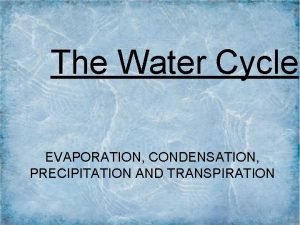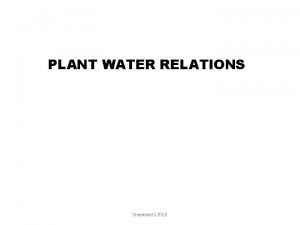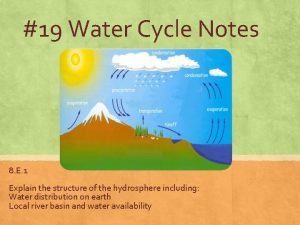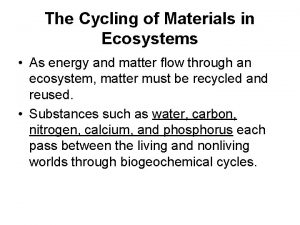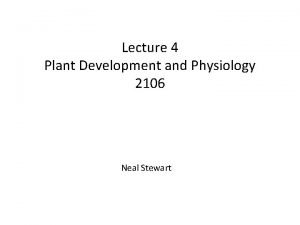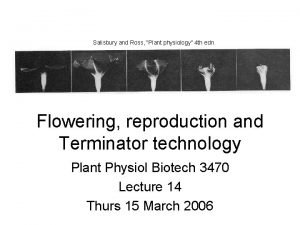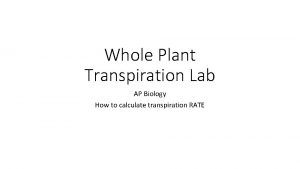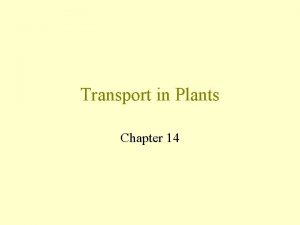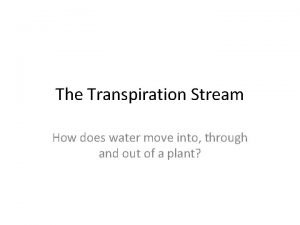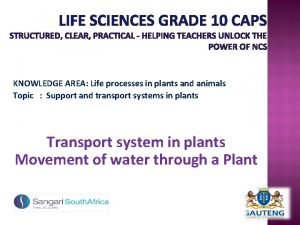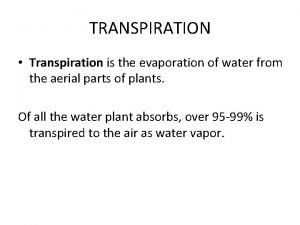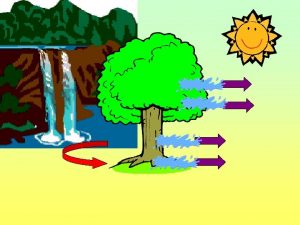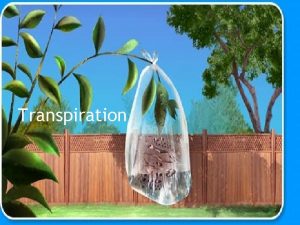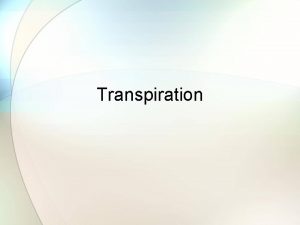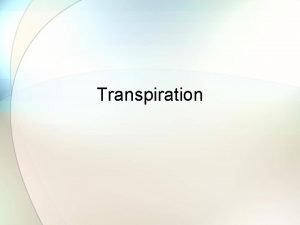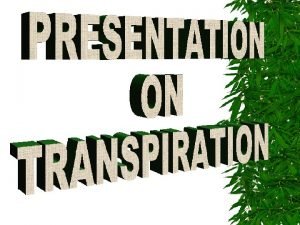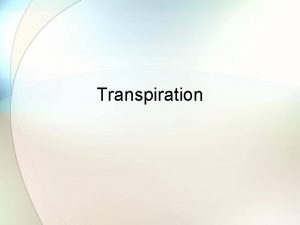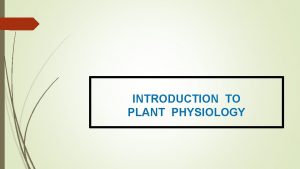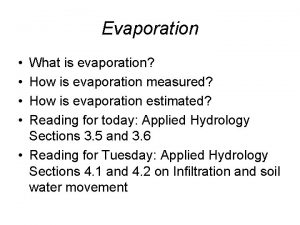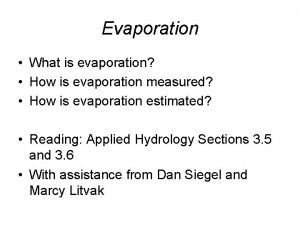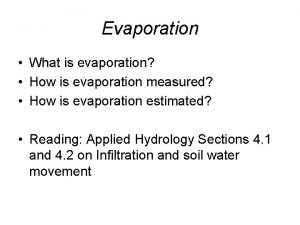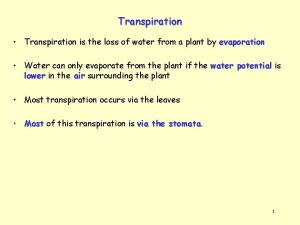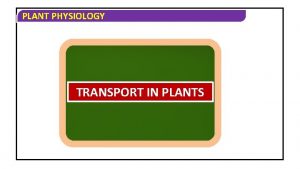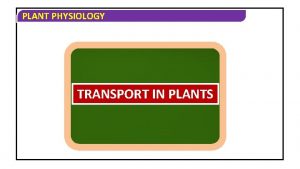Plant Physiology Transpiration The evaporation of water through
















- Slides: 16

Plant Physiology

Transpiration ● The evaporation of water through plant leaves and stems (usually through the stomata) ● It cools the plant and by moving water maintains the flow of nutrients and manufactured food from the root to the top and back

Transpiration ● Plants transpire more when: ○ ○ ○ The soil has adequate moisture, When windy and hot When humidity is low ● Water movement in plants is pulled up by the forces of cohesion and adhesion not pushed up by the roots

Photosynthesis ● Center of leaf are food-making cells that contain chloroplasts ○ ○ The green color comes from chlorophyll These cells manufacture food ● The process by which carbon dioxide and water in the presence of light energy are converted to sugar and oxygen

Photosynthesis ● The beginning of the food chain for ALL living things on earth 6 CO 2 + 6 H 2 O + light energy= C 6 H 12 O 6 + 6 O 2 carbon dioxide+water+light energy= glucose(sugar)+ oxygen

How Does Photosynthesis Work? • Chlorophyll uses the energy to split water molecules, H 2 O, during the first phase of the photosynthetic reaction. • Oxygen atoms from water molecules bond to form O 2. The O 2 escapes through the stomata into the atmosphere. • Hydrogen atoms from the water molecule are incorporated into sugar molecules as the process continues in CO 2 fixation.

How Does Photosynthesis Work? • During the CO 2 fixation phase of the photosynthetic reaction, energy in the form of ATP and NADPH is used to form sugars. • Carbon dioxide enters through the stomata and is available to the chlorophyll in the cells.

How Does Photosynthesis Work? • The CO 2 combines with hydrogen from the water molecule. • Two forms of sugar, glucose and fructose (C 6 H 12 O 6), are assembled. • Although they both have the same formula, the molecular structures differ.

How Does Photosynthesis Work? • Glucose and fructose fuel plant growth. • They are the source of energy for the plant’s life processes. • All live cells in the plant benefit as the sugars are transported through the phloem to the rest of the plant. • The simple sugars can also be combined to form a more complex sugar: sucrose (C 12 H 22 O 11).

How Does Photosynthesis Work? • The sugar molecules may be processed further to form starch and cellulose. • These are huge molecules, resulting from the bonding of thousands of glucose molecules. • Starch serves as the principle way in which food is stored for plants. • When needed, it is easily broken down into glucose or converted into other plant products by plant enzymes.

How Does Photosynthesis Work? • The cellulose is applied to cell walls for strength and rigidity. • Once sugars are converted to cellulose, they are not reclaimed for other purposes.

Respiration ● Plants respire 24 hours a day just as animals do ● In this process they consume oxygen and give off carbon dioxide ● Roots, stems and leaves all use oxygen as they grow

Respiration ● Plants produce more oxygen through photosynthesis than they consume through respiration and growth processes C 6 H 12 O 6 + 6 O 2 + 6 H 20 (ATP) 6 CO 2 + 12 H 20 + Energy

How Does Respiration Work? • Cellular respiration involves sugars produced in the photosynthetic process along with oxygen and water. • In the reaction, chemical energy is released when the molecular bonds of the sugar molecules are broken in combination with oxygen gas.

How Does Respiration Work? • The extracted energy, ATP, drives a variety of chemical reactions in the cell. • By-products of the reaction include carbon dioxide and water. • Water and carbon dioxide are released, as is all of the energy that was contained in the bonds of the glucose molecule.

Photosynthesis VS Respiration ● ● ● Food manufactured Sun’s energy is used Carbon dioxide used by plant Oxygen given off Complex compounds form Produces sugars and starches ● Requires light ● Chlorophyll must be present ● ● ● Food consumed Energy is released Carbon dioxide given off Oxygen is used Simple compounds form Produces carbon dioxide and water ● Goes on day and night ● Carried on in all cells
 Makna transpirasi
Makna transpirasi Transpiration
Transpiration Water and water and water water
Water and water and water water Water potential in transpiration
Water potential in transpiration Transpiration water cycle
Transpiration water cycle Cycling of materials
Cycling of materials Water molecule evaporation
Water molecule evaporation Evaporation water cycle
Evaporation water cycle Flippases function
Flippases function Plant celldiagram
Plant celldiagram Salisbury and ross
Salisbury and ross Ap biology transpiration lab
Ap biology transpiration lab Transpiration
Transpiration Significance of transpiration
Significance of transpiration Transpiration stream meaning
Transpiration stream meaning Geotropism
Geotropism Transpiration practical grade 10
Transpiration practical grade 10

